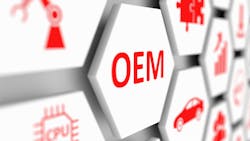Is OEM-based asset management right for your plant?
Kevin Price, a technical product evangelist for Infor, has spent most of his professional career working in the enterprise asset management software space. Angel Torres, Infor’s EAM practice lead and managing partner of VisualK, Infor’s Gold Channel Partner, is a problem solver with proven ability to innovate by integrating technology with EAM best practices.
During the live Q&A portion of the webinar, "How to Navigate the Challenges of OEM-Based Asset Management," Price and Torres tackled several attendee questions on OEM partnerships, security and much more.
PS: Lots of people are worried about providing secure access to their data to third parties like OEMs. Why are people so concerned about data sharing, and how do you help them address their concerns in their solutions and with their business cases?
KP: Some of the questions that come from security-minded organizations are related to getting data into third-party hands they don't know. Data elements like water utility or power utility are very protected. Unfortunately, the organization may have data points that are important to keep internal, not external. There could be a potential for terrorist events based on how the organization is set up. There could be different types of mining data that can be put out and provided competitively. How would I know that my information is safe?
You need to not only make sure that the data points are secure, are vetted, and have been reviewed by your IT organization, but also make sure the people are secure and vetted by your IT organization, and there are lots of different certifications that you can go through to make sure that you're accessing data (securely).
Then, when you access the third party, you can provide, through different types of portals, glimpses into your application. Maybe OEMs are coming in to do work management functions and you want to capture that information. Maybe you provide a portal for them to go in and access data in that way, or maybe you say, "You need to give us a flash file, which we'll run though and vet, and then we'll upload into our system so that we document when you did work." But the questions are valid when it comes to security. They always are. It's a matter of being open in the collaboration with yourself, with the OEM, with the third party and with your security organizations internally.
AT: One of the things that we see, especially with utilities, is that whenever data gets to a repository, an onsite buyer, or whatever, it's typically within the confines of your network. And that, for the most part, is pretty much secured. But if we look at the SCADA and the sensors out there in the fields, people are just beginning to realize that those are vulnerable, as well. People are kind of waking up to that.
PS: When you talk to your customers, how frequently do they bring in the finance team to help support their engineering argument with the business value members?
KP: Not frequently enough, and not at the right time. Procurement is not brought in frequently enough.
When you buy assets, engineering is trying to work with it, trying to get service level agreements in place, and they work with procurement to get there. They have expectations when they bought the asset that it's going to do a certain thing. You don't see those procurement people, and sometimes engineering people, get involved as frequently as they should. Having some agreed upon KPIs, some performance characteristics and indices, that you can be able to look at, that's the right way to do it.
The asset doesn't meet the expectation, (that’s when) procurement usually gets involved. Sometimes you hear, “We were supposed to have it running 24 hours a day, six out of the seven days a week, and now it's failing. We're only getting four days out of the week instead of the 24/6 days a week that we were expecting.” That's a tremendous SLA, but I didn't know that it was off. So they're brought in to settle an argument or to extend the pain and anguish that maintenance is providing.
PS: There seems to be a trend where the reliability teams are the ones that are most willing to consider working with an outside third party. I'm curious to know if you see any special acceptance of OEM support, OEM-based maintenance or OEM-based asset management.
KP: Unfortunately, it just depends. We do see a lot more aptitude around some of the more granular types of practices. You'll find this in life sciences, chemicals and pharmaceuticals. We'll see more reliability and more acceptance to bring in and have conversations with them. That reliability is what I've been referring to as the engineering department.
The engineering department, different from the maintenance organization, are the folks that are typically trying to make sure that assets are running as well as they should. They're not necessarily out there doing the work, but they're taking data elements, they're going into it, and typically, they're maintaining the relationship with the original equipment manufacturer, and they're not always sharing that data. They're not always sharing those people, but they're getting more involved.
I am seeing a resurgence of people with reliability in their title, description and practice. Back in the 1980s and 1990s, there was reliability. Then reliability-centered maintenance surged up around the 2000s, kind of went away, and now, it's coming back. Typically, we'll find those relationships, at least in reliably maintained by original equipment manufacturers, and a lot of times, they're very open to get it. Sometimes, they're not willing to share it outside of that, but that's not always the case.
AT: Typically, they're bringing in third parties more from an operations and maintenance standpoint, not necessarily a reliability standpoint. It tends to be more of an internal effort, which is typically done by somebody in engineering. Sometimes they just come short of getting to reliability and they get more into the “we can increase reliability by changing the current asset to the greatest and latest version of it.” Then it turns into a never-ending loop where people think that by operating and bring in new technologies, they're going to be more reliable, and perhaps they're not paying attention to the little details.


